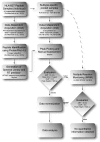Human Leukocyte Antigen (HLA) B27 Allotype-Specific Binding and Candidate Arthritogenic Peptides Revealed through Heuristic Clustering of Data-independent Acquisition Mass Spectrometry (DIA-MS) Data
- PMID: 26929215
- PMCID: PMC5083097
- DOI: 10.1074/mcp.M115.056358
Human Leukocyte Antigen (HLA) B27 Allotype-Specific Binding and Candidate Arthritogenic Peptides Revealed through Heuristic Clustering of Data-independent Acquisition Mass Spectrometry (DIA-MS) Data
Abstract
Expression of HLA-B27 is strongly associated with ankylosing spondylitis (AS) and other spondyloarthropathies. While this is true for the majority of HLA-B27 allotypes, HLA-B*27:06 and HLA-B*27:09 are not associated with AS. These two subtypes contain polymorphisms that are ideally positioned to influence the bound peptide repertoire. The existence of disease-inducing peptides (so-called arthritogenic peptides) has therefore been proposed that are exclusively presented by disease-associated HLA-B27 allotypes. However, we have recently demonstrated that this segregation of allotype-bound peptides is not the case and that many peptides that display sequence features predicted to favor binding to disease-associated subtypes are also capable of being presented naturally by protective alleles. To further probe more subtle quantitative changes in peptide presentation, we have used a combination of data-independent acquisition (DIA) and multiple reaction monitoring (MRM) mass spectrometry to quantify the abundance of 1646 HLA-B27 restricted peptides across the eight most frequent HLA-B27 allotypes (HLA-B*27:02-HLA-B*27:09). We utilized K means cluster analysis to group peptides with similar allelic binding preferences across the eight HLA-B27 allotypes, which enabled us to identify the most-stringent binding characteristics for each HLA-B27 allotype and further refined their existing consensus-binding motifs. Moreover, a thorough analysis of this quantitative dataset led to the identification of 26 peptides, which are presented in lower abundance by HLA-B*27:06 and HLA-B*27:09 compared with disease-associated HLA-B27 subtypes. Although these differences were observed to be very subtle, these 26 peptides might encompass the sought-after arthritogenic peptide(s).
© 2016 by The American Society for Biochemistry and Molecular Biology, Inc.
Figures


Similar articles
-
Revisiting the arthritogenic peptide theory: quantitative not qualitative changes in the peptide repertoire of HLA-B27 allotypes.Arthritis Rheumatol. 2015 Mar;67(3):702-13. doi: 10.1002/art.38963. Arthritis Rheumatol. 2015. PMID: 25418920
-
Natural HLA-B*2705 protein ligands with glutamine as anchor motif: implications for HLA-B27 association with spondyloarthropathy.J Biol Chem. 2013 Apr 12;288(15):10882-9. doi: 10.1074/jbc.M113.455352. Epub 2013 Feb 19. J Biol Chem. 2013. PMID: 23430249 Free PMC article.
-
Allelic association with ankylosing spondylitis fails to correlate with human leukocyte antigen B27 homodimer formation.J Biol Chem. 2019 Dec 27;294(52):20185-20195. doi: 10.1074/jbc.RA119.010257. Epub 2019 Nov 18. J Biol Chem. 2019. PMID: 31740583 Free PMC article.
-
HLA-B27 and pathogenesis of spondyloarthropathies.Curr Opin Rheumatol. 2002 Jul;14(4):367-72. doi: 10.1097/00002281-200207000-00006. Curr Opin Rheumatol. 2002. PMID: 12118169 Review.
-
HLA-B27.Annu Rev Immunol. 2015;33:29-48. doi: 10.1146/annurev-immunol-032414-112110. Annu Rev Immunol. 2015. PMID: 25861975 Review.
Cited by
-
Identification of Tumor Antigens Among the HLA Peptidomes of Glioblastoma Tumors and Plasma.Mol Cell Proteomics. 2018 Nov;17(11):2132-2145. doi: 10.1074/mcp.RA118.000792. Epub 2018 Aug 2. Mol Cell Proteomics. 2018. Retracted and republished in: Mol Cell Proteomics. 2019 Jun;18(6):1255-1268. doi: 10.1074/mcp.RA119.001524. Retraction in: Mol Cell Proteomics. 2019 Jun;18(6):1270. doi: 10.1074/mcp.W119.001571. PMID: 30072578 Free PMC article. Retracted and republished. Retracted.
-
Closer Peptide Repertoire Similarity of HLA-B∗14:03 and HLA-B∗27:05 Sheds Light on Ankylosing Spondylitis Susceptibility.Mol Cell Proteomics. 2025 Jul;24(7):101008. doi: 10.1016/j.mcpro.2025.101008. Epub 2025 Jun 2. Mol Cell Proteomics. 2025. PMID: 40466865 Free PMC article.
-
The Human Leukocyte Antigen (HLA)-B27 Peptidome in Vivo, in Spondyloarthritis-susceptible HLA-B27 Transgenic Rats and the Effect of Erap1 Deletion.Mol Cell Proteomics. 2017 Apr;16(4):642-662. doi: 10.1074/mcp.M116.066241. Epub 2017 Feb 10. Mol Cell Proteomics. 2017. PMID: 28188227 Free PMC article.
-
Sensitive Immunopeptidomics by Leveraging Available Large-Scale Multi-HLA Spectral Libraries, Data-Independent Acquisition, and MS/MS Prediction.Mol Cell Proteomics. 2021;20:100080. doi: 10.1016/j.mcpro.2021.100080. Epub 2021 Apr 9. Mol Cell Proteomics. 2021. PMID: 33845167 Free PMC article.
-
HLA-B57 micropolymorphism defines the sequence and conformational breadth of the immunopeptidome.Nat Commun. 2018 Nov 8;9(1):4693. doi: 10.1038/s41467-018-07109-w. Nat Commun. 2018. PMID: 30410026 Free PMC article.
References
-
- Garrett T. P., Saper M. A., Bjorkman P. J., Strominger J. L., and Wiley D. C. (1989) Specificity pockets for the side chains of peptide antigens in HLA-Aw68. Nature 342, 692–696 - PubMed
-
- Khan M. A., Mathieu A., Sorrentino R., and Akkoc N. (2007) The pathogenetic role of HLA-B27 and its subtypes. Autoimmun. Rev. 6, 183–189 - PubMed
-
- Khan M. A. (2013) Polymorphism of HLA-B27: 105 subtypes currently known. Curr. Rheumatol. Rep. 15, 362. - PubMed
-
- Rötzschke O., Falk K., Stevanović S., Gnau V., Jung G., and Rammensee H. G. (1994) Dominant aromatic/aliphatic C-terminal anchor in HLA-B*2702 and B*2705 peptide motifs. Immunogenetics 39, 74–77 - PubMed
-
- Colbert R. A., Rowland-Jones S. L., McMichael A. J., and Frelinger J. A. (1994) Differences in peptide presentation between B27 subtypes: The importance of the P1 side chain in maintaining high affinity peptide binding to B*2703. Immunity 1, 121–130 - PubMed
Publication types
MeSH terms
Substances
LinkOut - more resources
Full Text Sources
Other Literature Sources
Molecular Biology Databases
Research Materials

